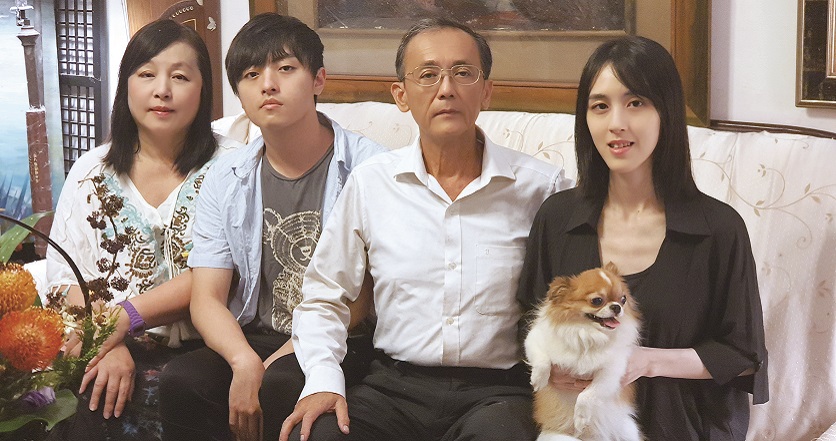A Photographer’s Conservation Efforts Take Flight
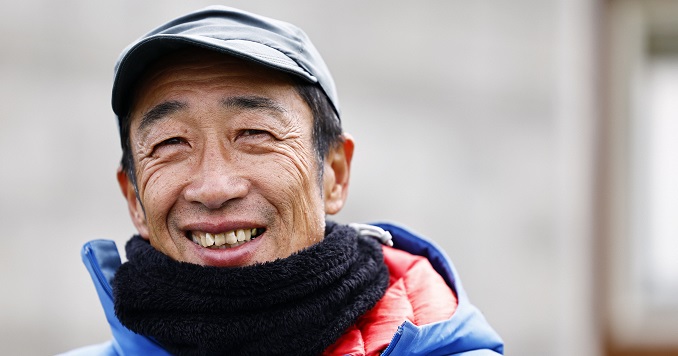
About an hour by ferry from Haboro Port in the northwestern part of Hokkaido, Teuri Island emerges, floating in the turquoise waters of the Sea of Japan. The small island, with a circumference of about 12 km, is a haven for seabirds. Nature photographer and Soka Gakkai member Takaki Terasawa has lived in the area for over four decades, surveying the seabirds and capturing their beauty through his camera lens. In this feature, Mr. Terasawa’s conservation efforts and motivations are brought to us by a reporter from the Soka Gakkai’s daily newspaper—the Seikyo Shimbun—who spent some time with Mr. Terasawa and the seabirds of Teuri Island.
Mr. Terasawa carefully maneuvers a small boat. As he rounds the western side of Teuri Island, seabirds are perched everywhere on the rocky cliffs.
The plumage of the Pelagic Cormorants, who have entered their breeding season, has turned from black to deep green and glows brightly in the sunlight. There are also approximately 5,000 Black-tailed Gulls in colonies (group breeding sites) occupying the grassy areas.
The birds happily flit about in the wind and their characteristic cries can be heard.
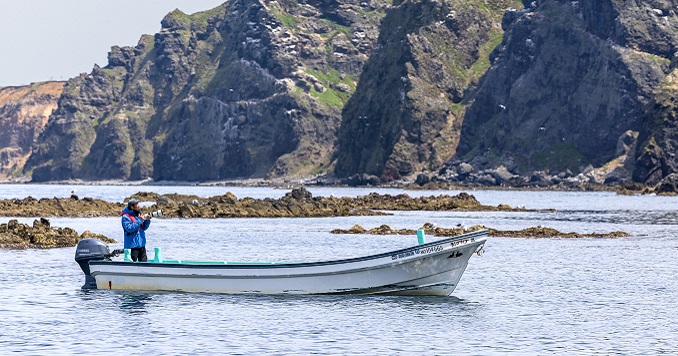
“Teuri Island is a rare miracle of an island. Here humans and nature coexist in harmony,” says Mr. Terasawa.
But, on this island, the Common Murre is one species that has been in danger of extinction. Teuri Island is its sole breeding ground in Japan.
After graduating from Hokkaido University of Education, Mr. Terasawa moved to Teuri Island in April 1982 and became a teacher. His aim was not only to teach the children there but also to observe and survey the seabirds.
“Until then, there had been some one-off surveys conducted, but no records had been compiled” he says.
Through a local islander, Mr. Terasawa also encountered the Soka Gakkai on Teuri Island. In addition to being moved by the person’s passion and conviction, the Buddhist concept of the oneness of life and its environment—the idea that if you change yourself, your circumstances will also change—resonated with Mr. Terasawa. In 1984, he decided to join the Soka Gakkai.
Teuri Island is a rare miracle of an island. Here humans and nature coexist in harmony.
At the time, Mr. Terasawa was concerned that the number of Common Murre—the symbol of Teuri Island—had been decreasing every year. In the 1930s, there was an estimated total of 40,000 the birds on the island, but numbers had plummeted for various reasons, including fatalities due to getting caught up in fishing nets and a decrease in sand lance fish—the main source of food for the birds.
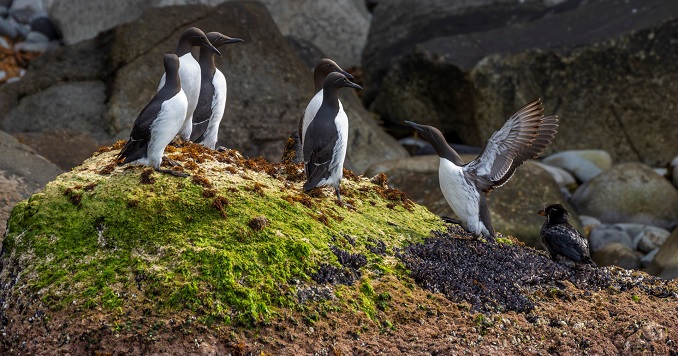
Mr. Terasawa called on the government and appealed to the press. Efforts to attract seabirds were also launched. At a rocky beach, he set up bird decoys and speakers to broadcast the birds’ calls to draw the Common Murre to the beach.
He shares, “I thought everyone would unanimously agree with these environmental protection activities.” However, he was met with resistance. For fishermen, the Common Murre was a nuisance that got trapped in their nets.
Turning Point
After teaching for 10 years, Mr. Terasawa retired and began his career as a nature photographer, hoping to build awareness of seabirds on Teuri Island.
In August 1994, Mr. Terasawa had the opportunity to hear President Daisaku Ikeda speak at the Soka Gakkai’s Hokkaido Training Center in the town of Betsukai. Mr. Terasawa was deeply struck by Mr. Ikeda’s explanation of the Buddhist concept of the three thousand realms in a single moment of life, which articulates the possibility that exists in each instant of one’s life. He was also moved by Mr. Ikeda’s explanation of the fundamental purpose of the Soka Gakkai and of one’s Buddhist practice—to construct a realm of happiness in one’s immediate environment as well as within society and the world at large. Based on this, Mr. Terasawa determined to work for the happiness and unity of everyone on the island through changing himself first rather than simply clinging on to his opinions of what was right or wrong.
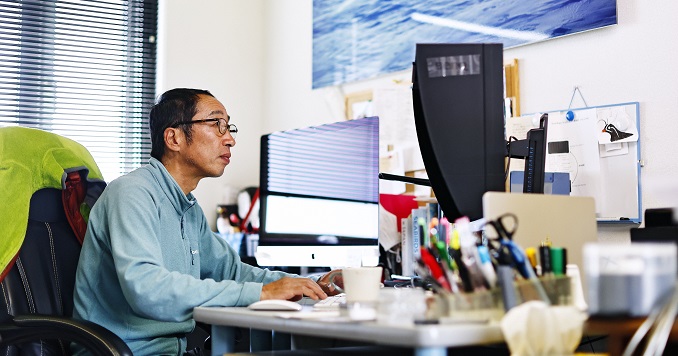
Observing seabirds on Teuri Island requires patience and perseverance to sit and wait all the while being exposed to the North wind. Mr. Terasawa persistently promoted conservation projects with the national and Hokkaido governments as well as with local towns. As a result of Mr. Terasawa’s tenacious efforts, the fishermen’s association also became increasingly aware of seabird protection activities. They made efforts to research and develop fishing nets that would not entangle birds, and also to relocate fishing grounds.
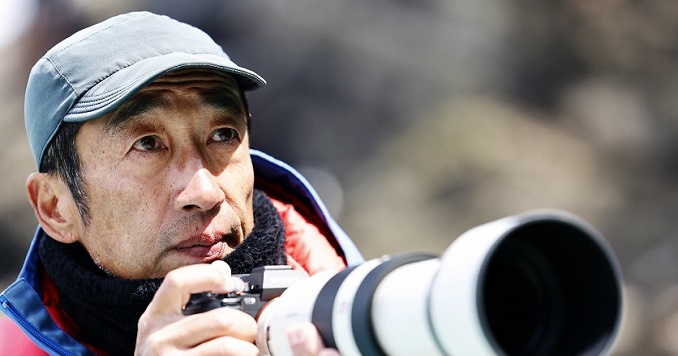
In 2002, there were only 13 Common Murres and only 15 in 2005. However, changes in people’s attitudes about the birds on the island and their united efforts gradually began to be reflected in the ecological environment, leading to an increase of the birds on the island. Between April and July of 2022, Mr. Terasawa was overjoyed to observe over 100 Common Murres through the viewfinder of his camera.
Another challenge was learning more about the Spectacled Guillemot, which is said to be the most beautiful bird on the island. Its ecology has long been shrouded in mystery as it nests in the rocky cliffs and their precipices.
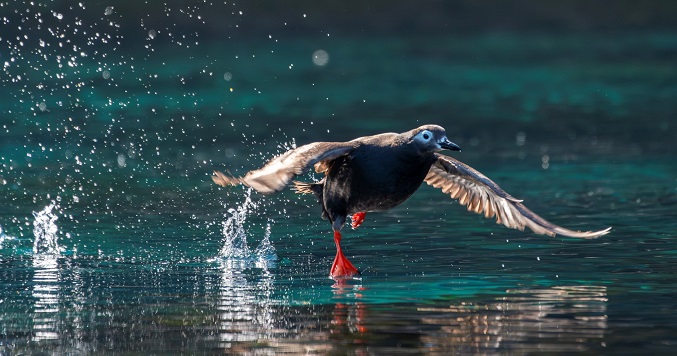
In April 2019, Mr. Terasawa was the first person in the world to successfully film the burrow of the Spectacled Guillemot with an ultra-high-definition video camera. Since then, images he has captured during the annual breeding season have been featured in the Japan Broadcasting Corporation (NHK)’s nature documentary program on the Spectacled Guillemot.
He says, “Teuri Island is a place where all things coexist in harmony. We must protect this island and its nature.” With this in mind, Mr. Terasawa published a collection of photographs capturing fleeting moments of beautiful seabirds and has also held numerous photo exhibitions and seminars around Japan.
Guided by the calls of seabirds and with his camera at the ready, Mr. Terasawa is now helping to expand awareness of the plight of marine wildlife around the globe, from his base Teuri Island to polar and tropical regions.
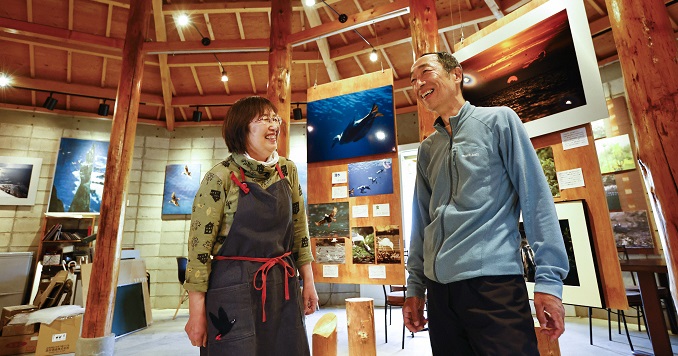
Adapted from the May 16, 2023, issue of the Seikyo Shimbun, Soka Gakkai, Japan






